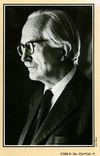Close Quarters
Close Quarters is the first novel by the British mystery writer Michael Gilbert. Published in England by Hodder & Stoughton in 1947, it did not appear in the United States until 1963. By then Gilbert's reputation had been firmly established in both countries and his regular American publisher for many years had been Harper & Row. Close Quarters, however, was published by Walker and Company, a less prestigious house. In it we are introduced to Inspector Hazlerigg, who will go on to be a recurring character in a number of Gilbert's works throughout the next ten years.
The novel's form is that of many of the Golden Age mysteries that had been popularized during the 1930s by writers such as Agatha Christie, Dorothy L. Sayers, and Michael Innes. It is difficult to discern the author's actual intentions: it may be a parody presented with a straight face, or it may be a clever pastiche. Since its events take place in 1937, two years before the outbreak of World War II, it is most likely an ingenuous attempt to mimic the works of that era. A series of deaths, the first one an apparent accident, take place in the normally quiet cathedral town of Welchester, more particularly within the "Close" of the 500-year old cathedral itself, "Close" being the English word for the precincts of a cathedral.
Many of the classic detective story's typical features are to be found here. Its setting is the tightly limited confines of the cathedral Close and those few houses within its exterior walls, much as many Golden Age stories were set in isolated country houses; two full pages are devoted to a complete cast of the "householders" inhabiting the Close; the main characters (and suspects) are strictly limited to those ecclesiastics living within these confines; we have three full-page diagrams showing the grounds of the Close with its cathedral and houses; an inspector and sergeant are sent down from Scotland Yard to conduct the inquiries; a loving imitation of a London Times crossword puzzle is presented, along with its recondite clues, and is the subject of an entire chapter, with three iterations of the puzzle itself being shown as it is gradually filled in by two of the story's scholarly characters; there is much leisurely description of the cathedral, the neighboring houses, and of the characters themselves; and there is one lengthy red herring in which the detective sergeant follows two of the suspects to London to no great purpose.
Characteristic of much of Gilbert's work over the next half-century is his use of teen-aged boys as being relatively important characters—in this he is practically unique in the field: in very few of his peers' works are any characters except adults shown. Also characteristic of his works to come is the deceptively hard edge he brings to the story as progresses. What begins as a relatively light-hearted depiction of the Close and its ecclesiastic inhabitants becomes darker and grimmer as the events unfold in sometimes surprising ways. "He's not a hard-boiled writer in the classic sense, but there is a hard edge to him, a feeling within his work that not all of society is rational, that virtue is not always rewarded.".[1]
Credibility
Notes
- ↑ Douglas Greene of Crippen & Landrau, quoted in The New York Times, 15 February 2006
